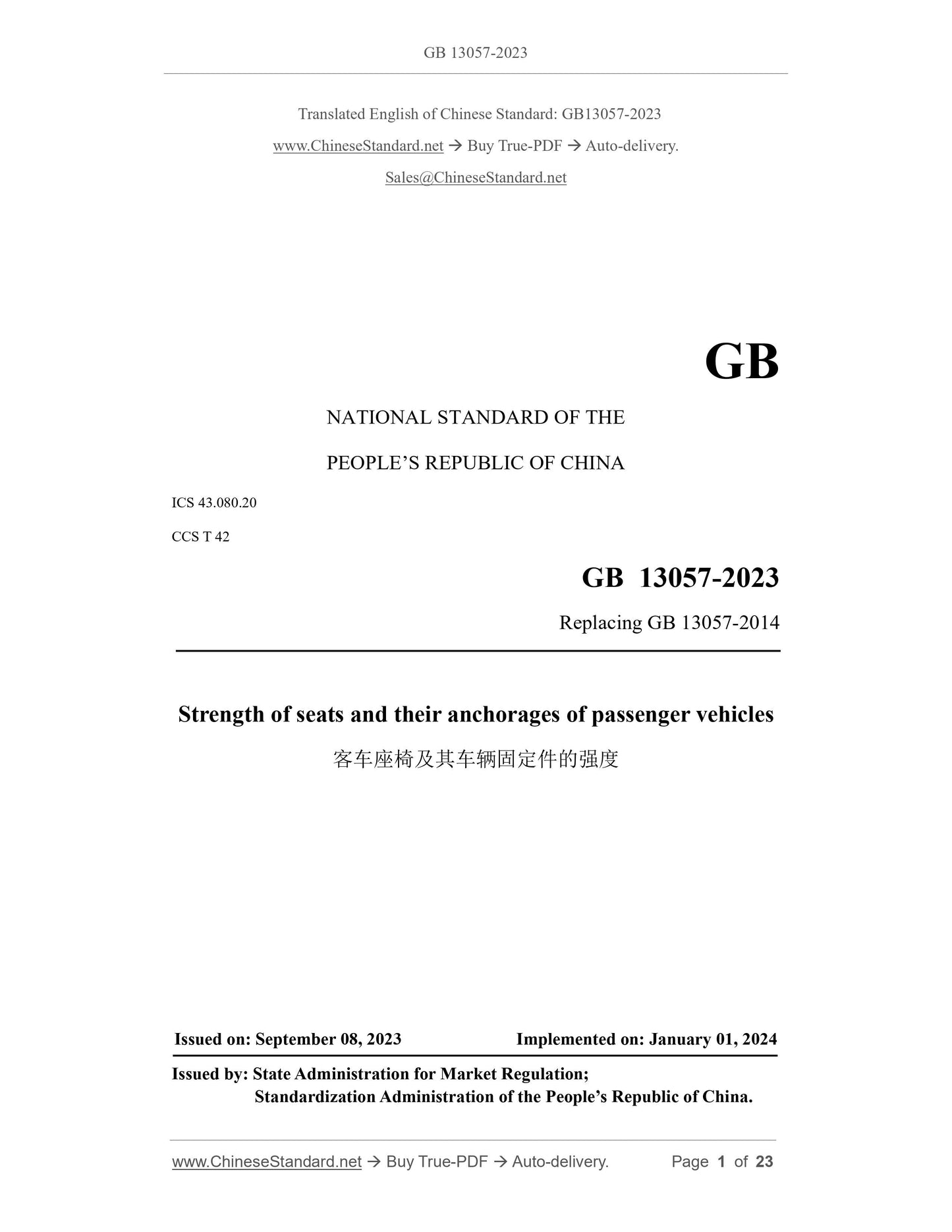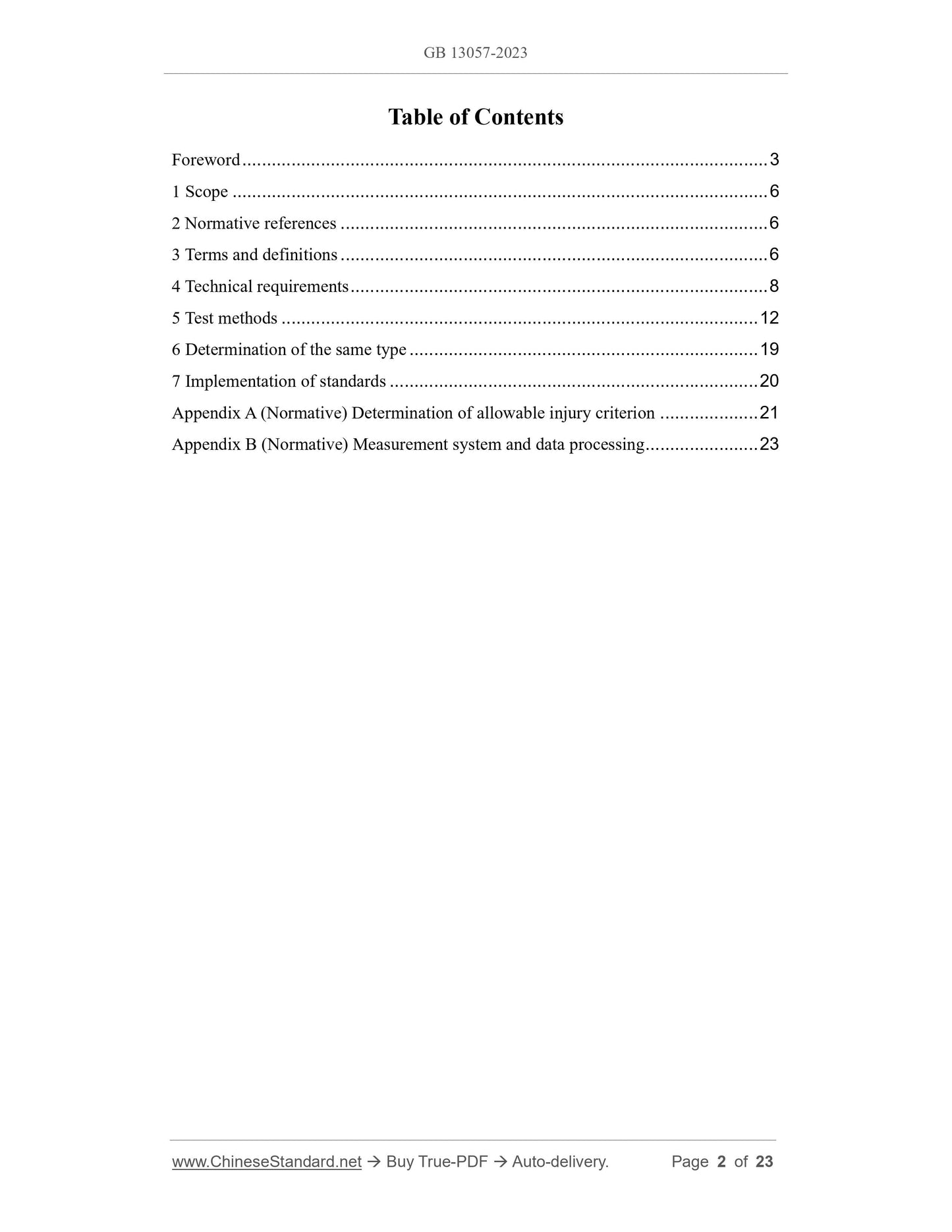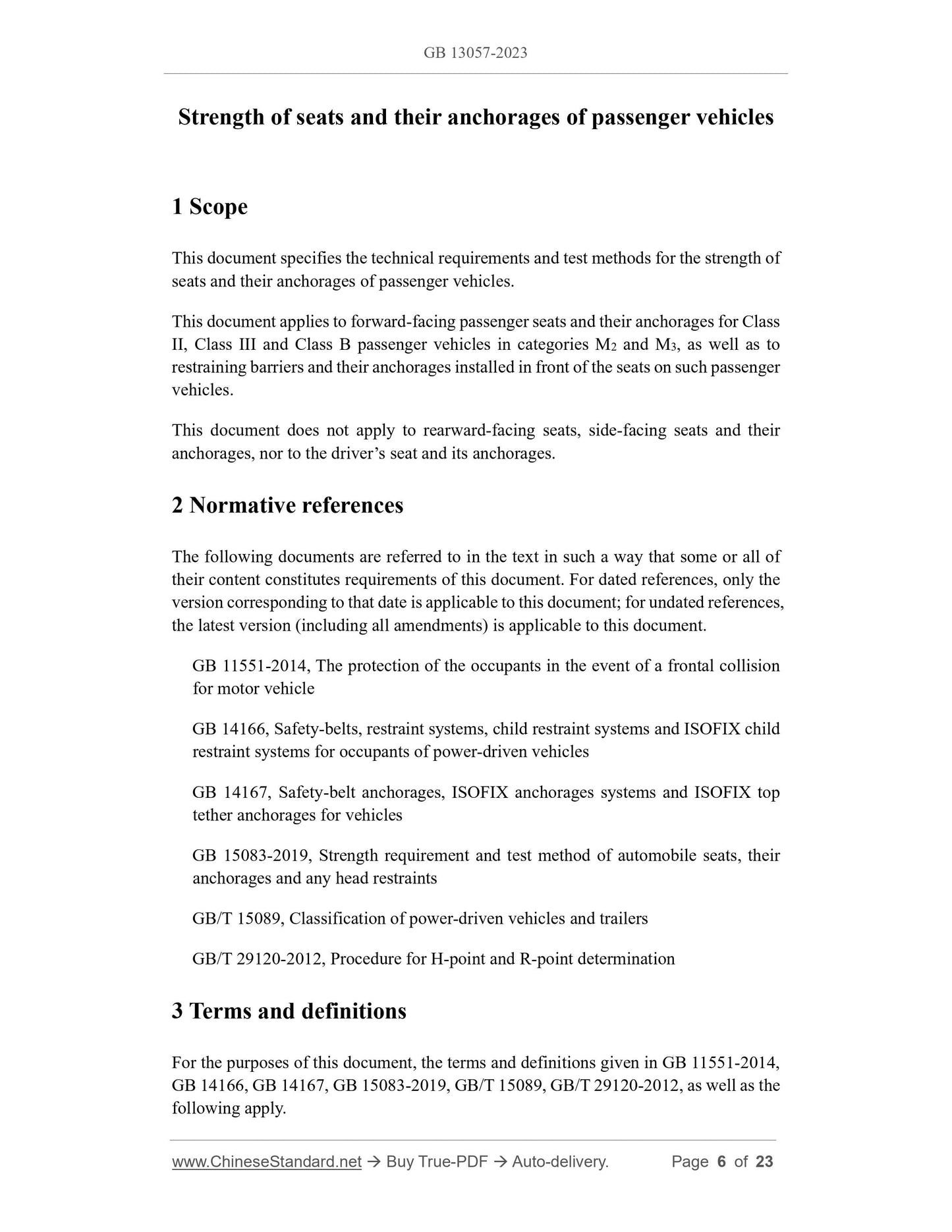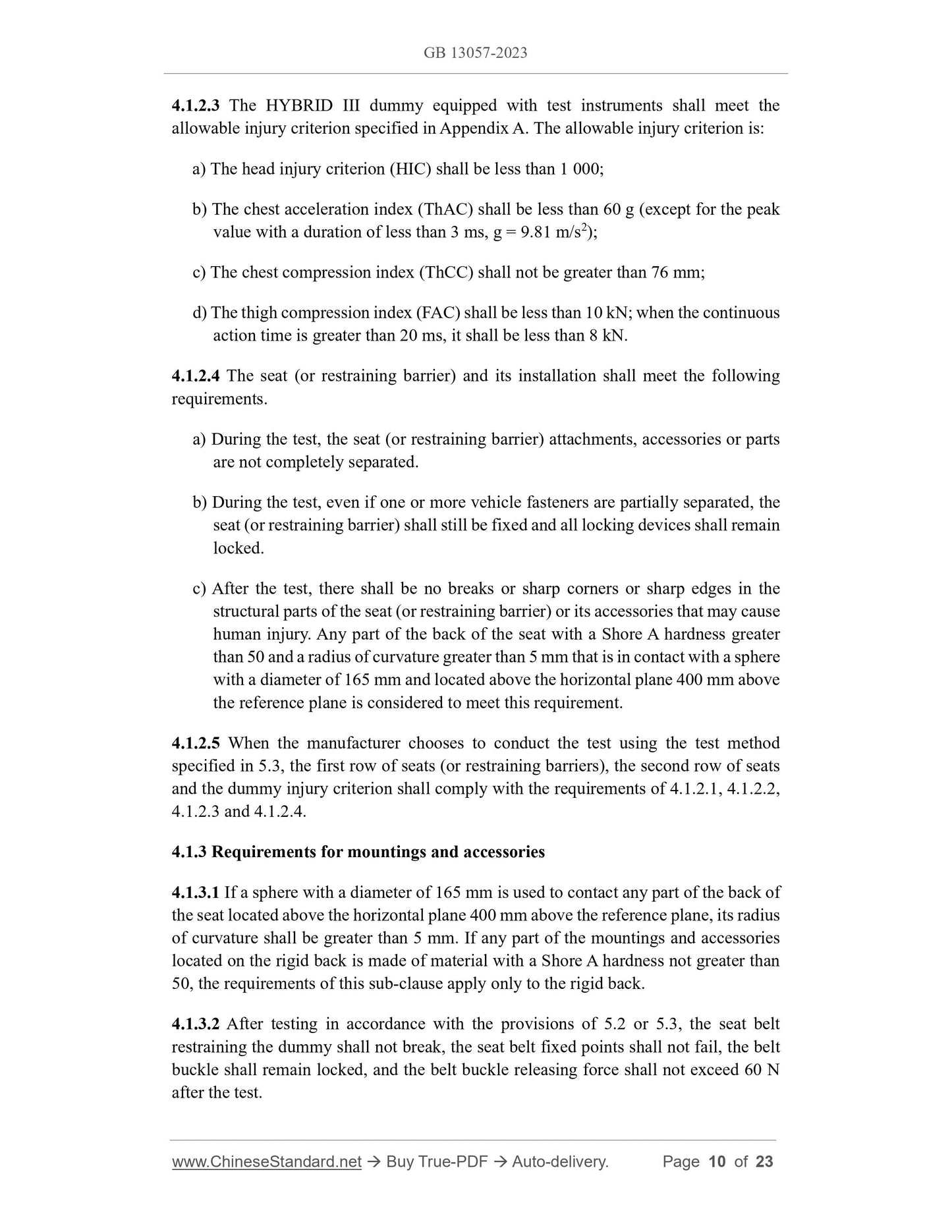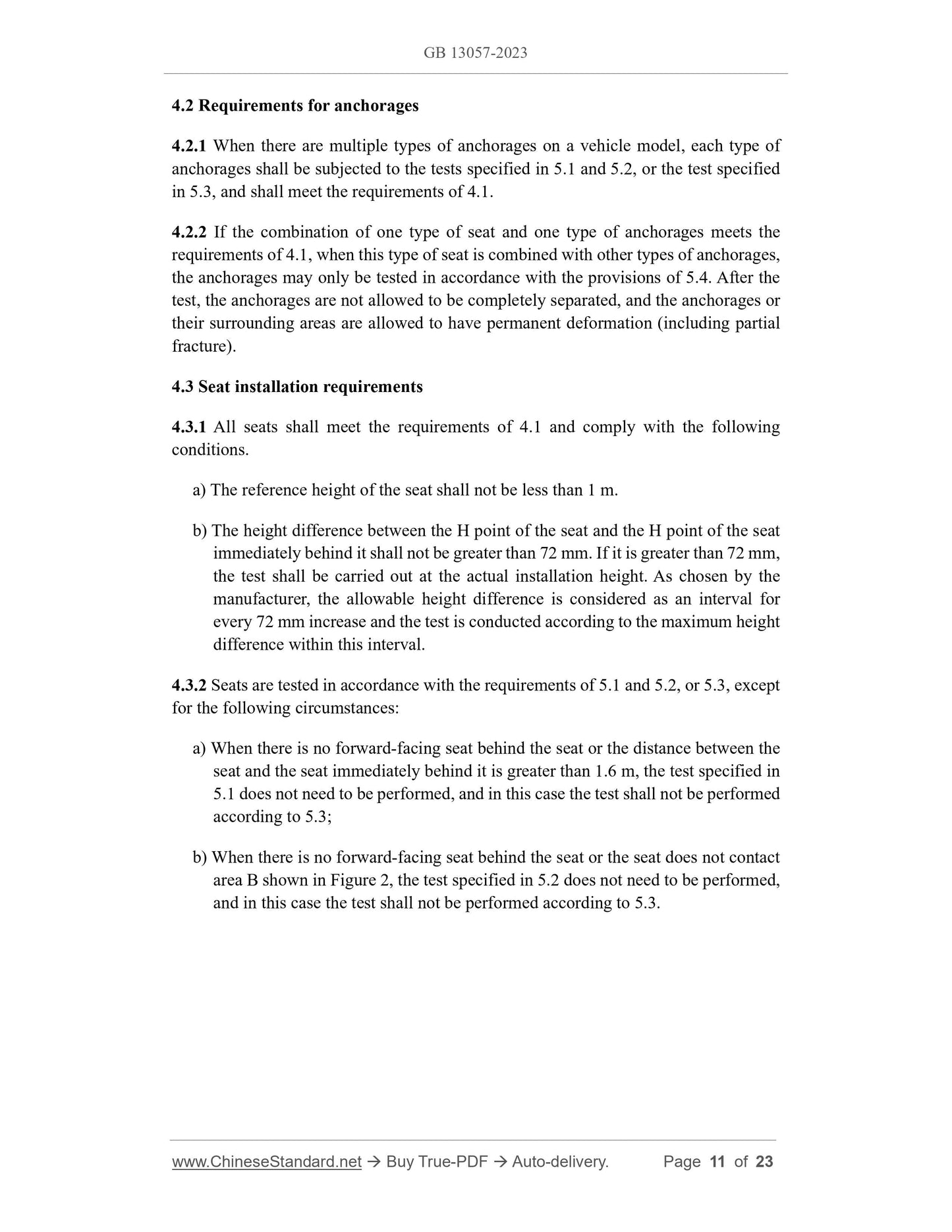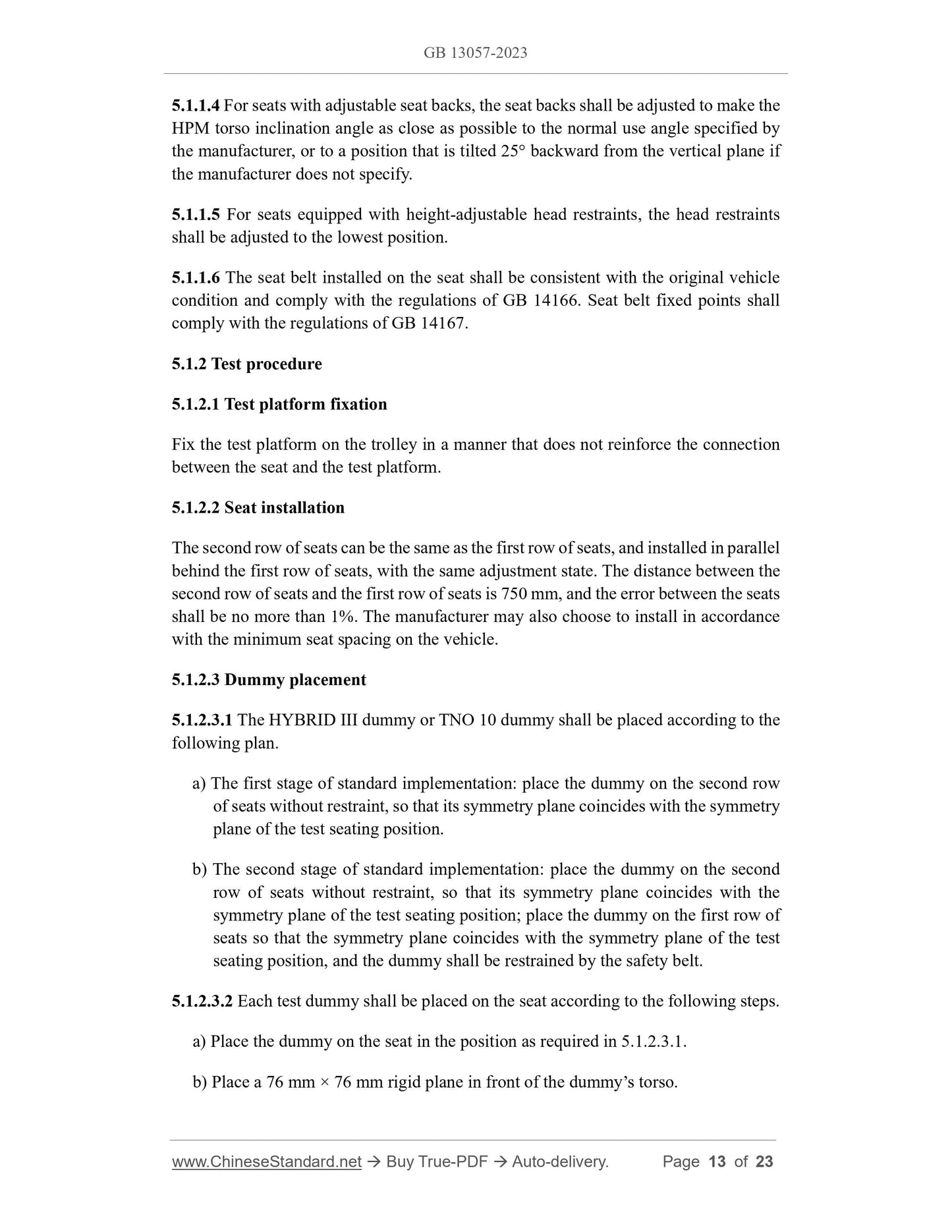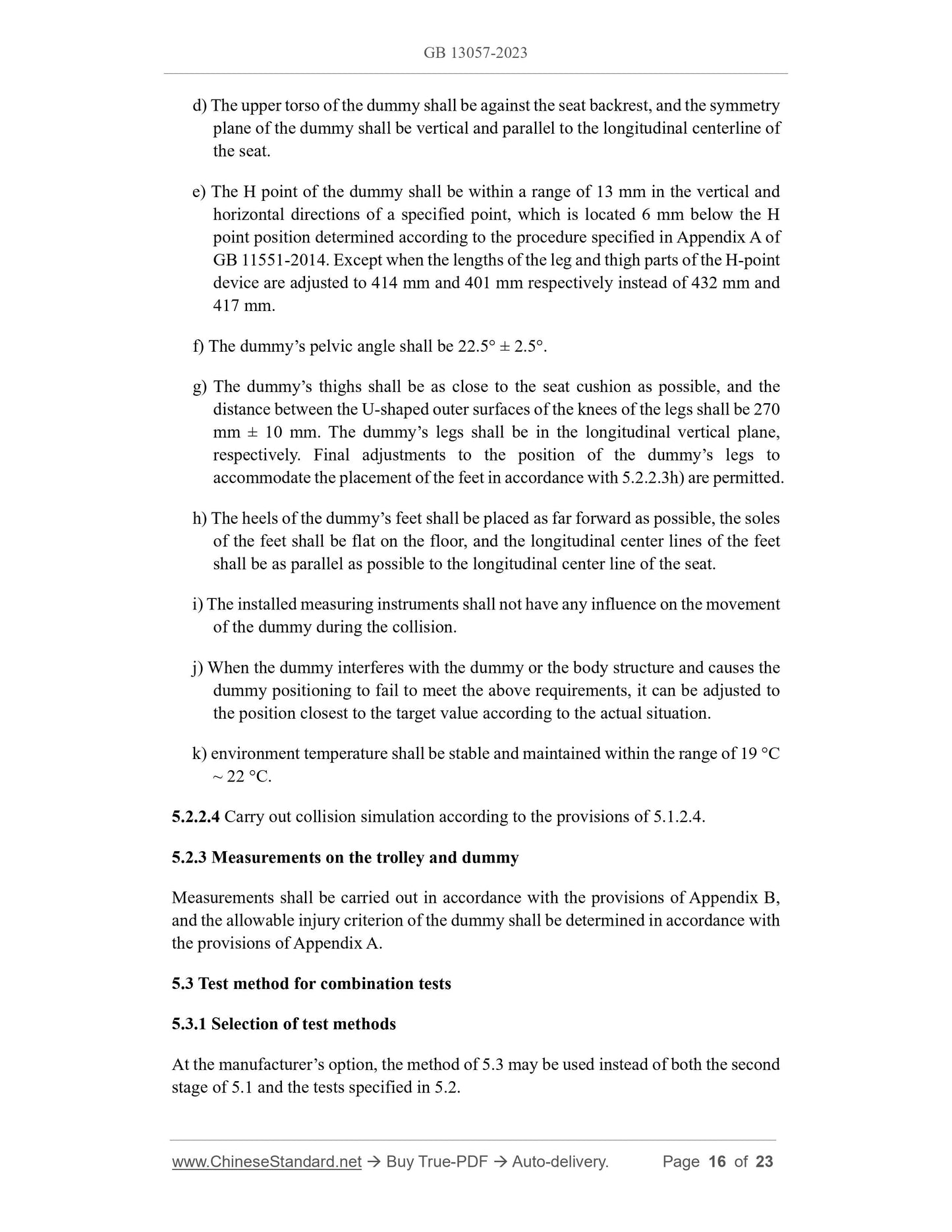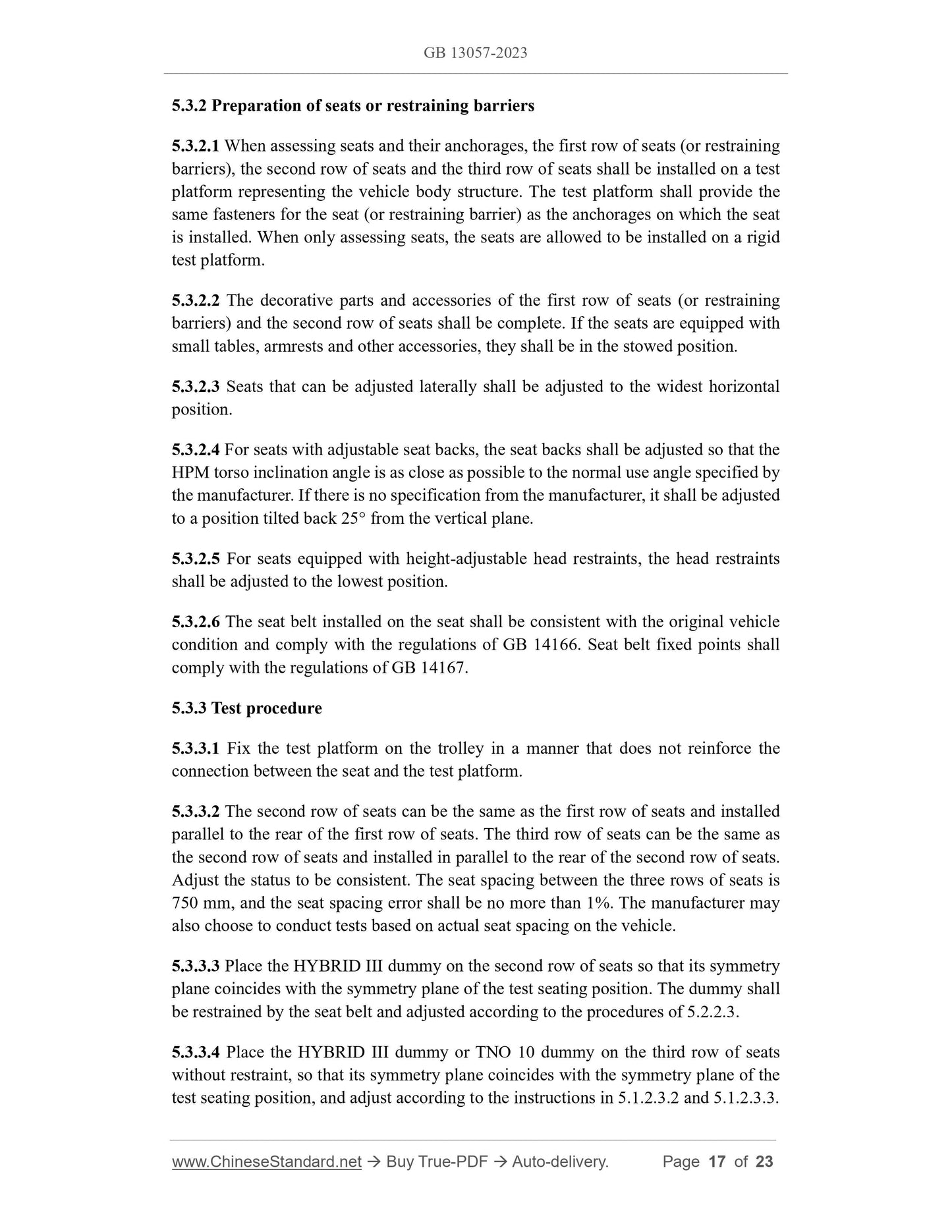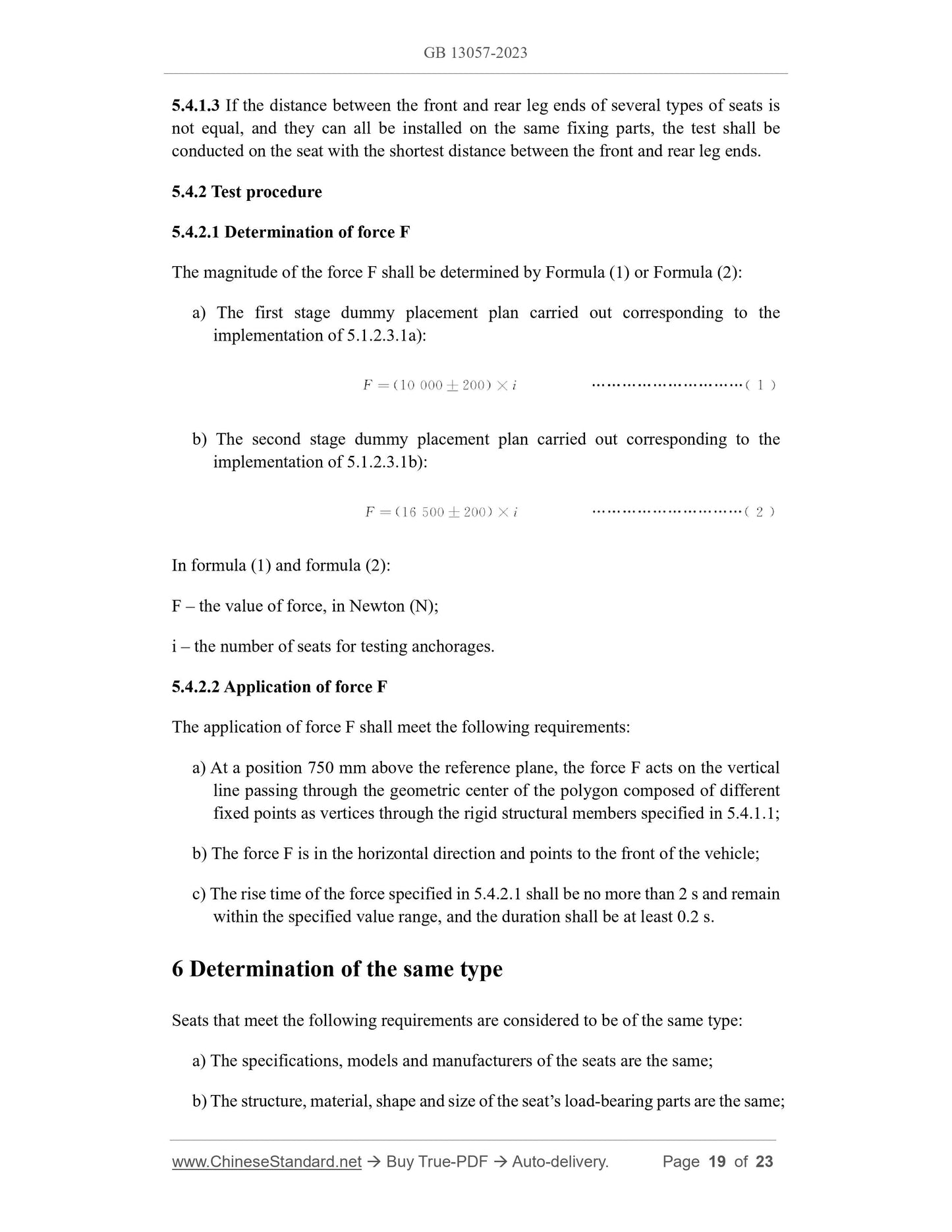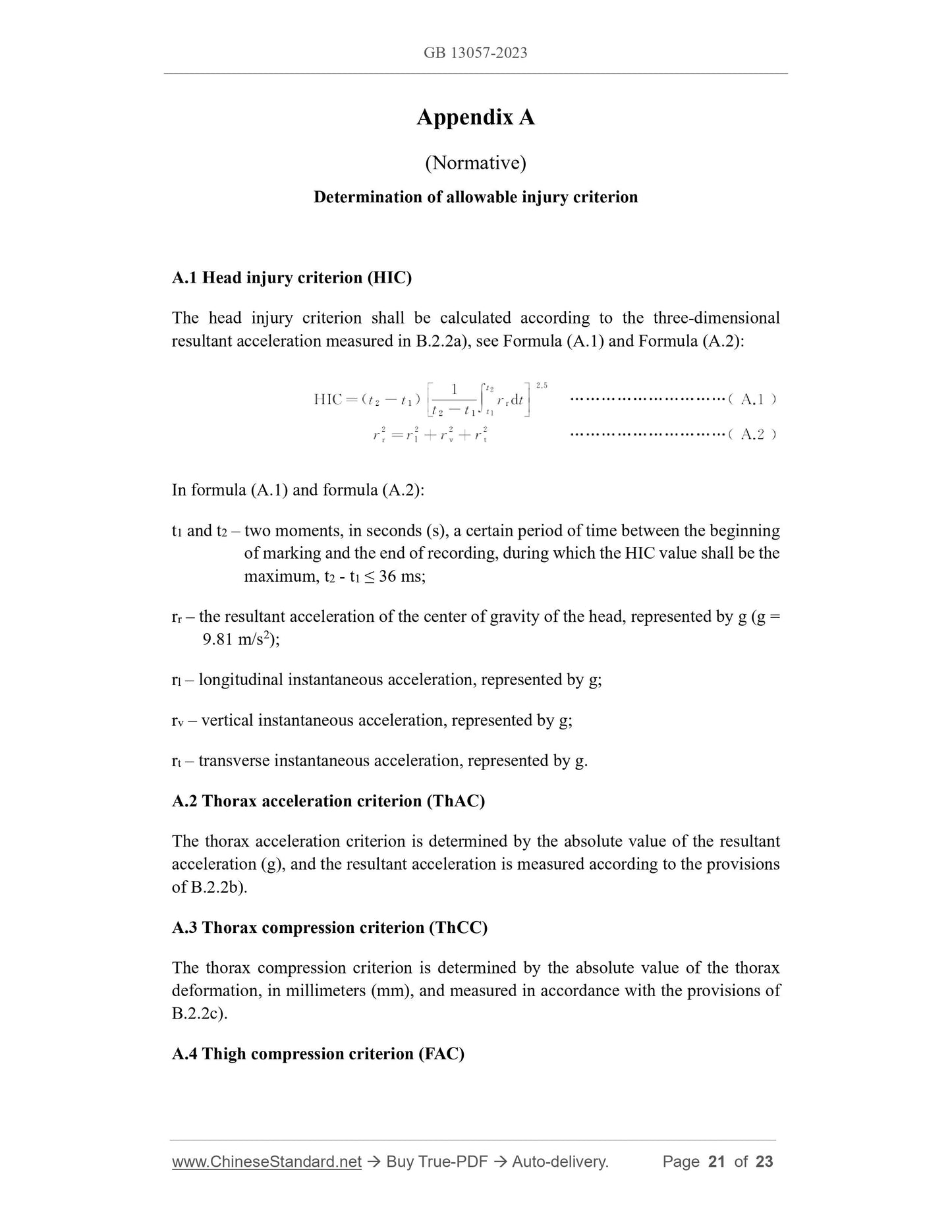1
/
de
10
PayPal, credit cards. Download editable-PDF and invoice in 1 second!
GB 13057-2023 English PDF (GB13057-2023)
GB 13057-2023 English PDF (GB13057-2023)
Prix habituel
$245.00 USD
Prix habituel
Prix promotionnel
$245.00 USD
Prix unitaire
/
par
Frais d'expédition calculés à l'étape de paiement.
Impossible de charger la disponibilité du service de retrait
Delivery: 3 seconds. Download true-PDF + Invoice.
Get QUOTATION in 1-minute: Click GB 13057-2023
Historical versions: GB 13057-2023
Preview True-PDF (Reload/Scroll if blank)
GB 13057-2023: Strength of seats and their anchorages of passenger vehicles
GB 13057-2023
GB
NATIONAL STANDARD OF THE
PEOPLE’S REPUBLIC OF CHINA
ICS 43.080.20
CCS T 42
Replacing GB 13057-2014
Strength of seats and their anchorages of passenger vehicles
ISSUED ON: SEPTEMBER 08, 2023
IMPLEMENTED ON: JANUARY 01, 2024
Issued by: State Administration for Market Regulation;
Standardization Administration of the People’s Republic of China.
Table of Contents
Foreword ... 3
1 Scope ... 6
2 Normative references ... 6
3 Terms and definitions ... 6
4 Technical requirements ... 8
5 Test methods ... 12
6 Determination of the same type ... 19
7 Implementation of standards ... 20
Appendix A (Normative) Determination of allowable injury criterion ... 21
Appendix B (Normative) Measurement system and data processing ... 23
Strength of seats and their anchorages of passenger vehicles
1 Scope
This document specifies the technical requirements and test methods for the strength of
seats and their anchorages of passenger vehicles.
This document applies to forward-facing passenger seats and their anchorages for Class
II, Class III and Class B passenger vehicles in categories M2 and M3, as well as to
restraining barriers and their anchorages installed in front of the seats on such passenger
vehicles.
This document does not apply to rearward-facing seats, side-facing seats and their
anchorages, nor to the driver’s seat and its anchorages.
2 Normative references
The following documents are referred to in the text in such a way that some or all of
their content constitutes requirements of this document. For dated references, only the
version corresponding to that date is applicable to this document; for undated references,
the latest version (including all amendments) is applicable to this document.
GB 11551-2014, The protection of the occupants in the event of a frontal collision
for motor vehicle
GB 14166, Safety-belts, restraint systems, child restraint systems and ISOFIX child
restraint systems for occupants of power-driven vehicles
GB 14167, Safety-belt anchorages, ISOFIX anchorages systems and ISOFIX top
tether anchorages for vehicles
GB 15083-2019, Strength requirement and test method of automobile seats, their
anchorages and any head restraints
GB/T 15089, Classification of power-driven vehicles and trailers
GB/T 29120-2012, Procedure for H-point and R-point determination
3 Terms and definitions
For the purposes of this document, the terms and definitions given in GB 11551-2014,
GB 14166, GB 14167, GB 15083-2019, GB/T 15089, GB/T 29120-2012, as well as the
following apply.
4.1.2.3 The HYBRID III dummy equipped with test instruments shall meet the
allowable injury criterion specified in Appendix A. The allowable injury criterion is:
a) The head injury criterion (HIC) shall be less than 1 000;
b) The chest acceleration index (ThAC) shall be less than 60 g (except for the peak
value with a duration of less than 3 ms, g = 9.81 m/s2);
c) The chest compression index (ThCC) shall not be greater than 76 mm;
d) The thigh compression index (FAC) shall be less than 10 kN; when the continuous
action time is greater than 20 ms, it shall be less than 8 kN.
4.1.2.4 The seat (or restraining barrier) and its installation shall meet the following
requirements.
a) During the test, the seat (or restraining barrier) attachments, accessories or parts
are not completely separated.
b) During the test, even if one or more vehicle fasteners are partially separated, the
seat (or restraining barrier) shall still be fixed and all locking devices shall remain
locked.
c) After the test, there shall be no breaks or sharp corners or sharp edges in the
structural parts of the seat (or restraining barrier) or its accessories that may cause
human injury. Any part of the back of the seat with a Shore A hardness greater
than 50 and a radius of curvature greater than 5 mm that is in contact with a sphere
with a diameter of 165 mm and located above the horizontal plane 400 mm above
the reference plane is considered to meet this requirement.
4.1.2.5 When the manufacturer chooses to conduct the test using the test method
specified in 5.3, the first row of seats (or restraining barriers), the second row of seats
and the dummy injury criterion shall comply with the requirements of 4.1.2.1, 4.1.2.2,
4.1.2.3 and 4.1.2.4.
4.1.3 Requirements for mountings and accessories
4.1.3.1 If a sphere with a diameter of 165 mm is used to contact any part of the back of
the seat located above the horizontal plane 400 mm above the reference plane, its radius
of curvature shall be greater than 5 mm. If any part of the mountings and accessories
located on the rigid back is made of material with a Shore A hardness not greater than
50, the requirements of this sub-clause apply only to the rigid back.
4.1.3.2 After testing in accordance with the provisions of 5.2 or 5.3, the seat belt
restraining the dummy shall not break, the seat belt fixed points shall not fail, the belt
buckle shall remain locked, and the belt buckle releasing force shall not exceed 60 N
after the test.
4.2 Requirements for anchorages
4.2.1 When there are multiple types of anchorages on a vehicle model, each type of
anchorages shall be subjected to the tests specified in 5.1 and 5.2, or the test specified
in 5.3, and shall meet the requirements of 4.1.
4.2.2 If the combination of one type of seat and one type of anchorages meets the
requirements of 4.1, when this type of seat is combined with other types of anchorages,
the anchorages may only be tested in accordance with the provisions of 5.4. After the
test, the anchorages are not allowed to be completely separated, and the anchorages or
their surrounding areas are allowed to have permanent deformation (including partial
fracture).
4.3 Seat installation requirements
4.3.1 All seats shall meet the requirements of 4.1 and comply with the following
conditions.
a) The reference height of the seat shall not be less than 1 m.
b) The height difference between the H point of the seat and the H point of the seat
immediately behind it shall not be greater than 72 mm. If it is greater than 72 mm,
the test shall be carried out at the actual installation height. As chosen by the
manufacturer, the allowable height difference is considered as an interval for
every 72 mm increase and the test is conducted according to the maximum height
difference within this interval.
4.3.2 Seats are tested in accordance with the requirements of 5.1 and 5.2, or 5.3, except
for the following circumstances:
a) When there is no forward-facing seat behind the seat or the distance between the
seat and the seat immediately behind it is greater than 1.6 m, the test specified in
5.1 does not need to be performed, and in this case the test shall not be performed
according to 5.3;
b) When there is no forward-facing seat behind the seat or the seat does not contact
area B shown in Figure 2, the test specified in 5.2 does not need to be performed,
and in this case the test shall not be performed according to 5.3.
5.1.1.4 For seats with adjustable seat backs, the seat backs shall be adjusted to make the
HPM torso inclination angle as close as possible to the normal use angle specified by
the manufacturer, or to a position that is tilted 25° backward from the vertical plane if
the manufacturer does not specify.
5.1.1.5 For seats equipped with height-adjustable head restraints, the head restraints
shall be adjusted to the lowest position. ...
Get QUOTATION in 1-minute: Click GB 13057-2023
Historical versions: GB 13057-2023
Preview True-PDF (Reload/Scroll if blank)
GB 13057-2023: Strength of seats and their anchorages of passenger vehicles
GB 13057-2023
GB
NATIONAL STANDARD OF THE
PEOPLE’S REPUBLIC OF CHINA
ICS 43.080.20
CCS T 42
Replacing GB 13057-2014
Strength of seats and their anchorages of passenger vehicles
ISSUED ON: SEPTEMBER 08, 2023
IMPLEMENTED ON: JANUARY 01, 2024
Issued by: State Administration for Market Regulation;
Standardization Administration of the People’s Republic of China.
Table of Contents
Foreword ... 3
1 Scope ... 6
2 Normative references ... 6
3 Terms and definitions ... 6
4 Technical requirements ... 8
5 Test methods ... 12
6 Determination of the same type ... 19
7 Implementation of standards ... 20
Appendix A (Normative) Determination of allowable injury criterion ... 21
Appendix B (Normative) Measurement system and data processing ... 23
Strength of seats and their anchorages of passenger vehicles
1 Scope
This document specifies the technical requirements and test methods for the strength of
seats and their anchorages of passenger vehicles.
This document applies to forward-facing passenger seats and their anchorages for Class
II, Class III and Class B passenger vehicles in categories M2 and M3, as well as to
restraining barriers and their anchorages installed in front of the seats on such passenger
vehicles.
This document does not apply to rearward-facing seats, side-facing seats and their
anchorages, nor to the driver’s seat and its anchorages.
2 Normative references
The following documents are referred to in the text in such a way that some or all of
their content constitutes requirements of this document. For dated references, only the
version corresponding to that date is applicable to this document; for undated references,
the latest version (including all amendments) is applicable to this document.
GB 11551-2014, The protection of the occupants in the event of a frontal collision
for motor vehicle
GB 14166, Safety-belts, restraint systems, child restraint systems and ISOFIX child
restraint systems for occupants of power-driven vehicles
GB 14167, Safety-belt anchorages, ISOFIX anchorages systems and ISOFIX top
tether anchorages for vehicles
GB 15083-2019, Strength requirement and test method of automobile seats, their
anchorages and any head restraints
GB/T 15089, Classification of power-driven vehicles and trailers
GB/T 29120-2012, Procedure for H-point and R-point determination
3 Terms and definitions
For the purposes of this document, the terms and definitions given in GB 11551-2014,
GB 14166, GB 14167, GB 15083-2019, GB/T 15089, GB/T 29120-2012, as well as the
following apply.
4.1.2.3 The HYBRID III dummy equipped with test instruments shall meet the
allowable injury criterion specified in Appendix A. The allowable injury criterion is:
a) The head injury criterion (HIC) shall be less than 1 000;
b) The chest acceleration index (ThAC) shall be less than 60 g (except for the peak
value with a duration of less than 3 ms, g = 9.81 m/s2);
c) The chest compression index (ThCC) shall not be greater than 76 mm;
d) The thigh compression index (FAC) shall be less than 10 kN; when the continuous
action time is greater than 20 ms, it shall be less than 8 kN.
4.1.2.4 The seat (or restraining barrier) and its installation shall meet the following
requirements.
a) During the test, the seat (or restraining barrier) attachments, accessories or parts
are not completely separated.
b) During the test, even if one or more vehicle fasteners are partially separated, the
seat (or restraining barrier) shall still be fixed and all locking devices shall remain
locked.
c) After the test, there shall be no breaks or sharp corners or sharp edges in the
structural parts of the seat (or restraining barrier) or its accessories that may cause
human injury. Any part of the back of the seat with a Shore A hardness greater
than 50 and a radius of curvature greater than 5 mm that is in contact with a sphere
with a diameter of 165 mm and located above the horizontal plane 400 mm above
the reference plane is considered to meet this requirement.
4.1.2.5 When the manufacturer chooses to conduct the test using the test method
specified in 5.3, the first row of seats (or restraining barriers), the second row of seats
and the dummy injury criterion shall comply with the requirements of 4.1.2.1, 4.1.2.2,
4.1.2.3 and 4.1.2.4.
4.1.3 Requirements for mountings and accessories
4.1.3.1 If a sphere with a diameter of 165 mm is used to contact any part of the back of
the seat located above the horizontal plane 400 mm above the reference plane, its radius
of curvature shall be greater than 5 mm. If any part of the mountings and accessories
located on the rigid back is made of material with a Shore A hardness not greater than
50, the requirements of this sub-clause apply only to the rigid back.
4.1.3.2 After testing in accordance with the provisions of 5.2 or 5.3, the seat belt
restraining the dummy shall not break, the seat belt fixed points shall not fail, the belt
buckle shall remain locked, and the belt buckle releasing force shall not exceed 60 N
after the test.
4.2 Requirements for anchorages
4.2.1 When there are multiple types of anchorages on a vehicle model, each type of
anchorages shall be subjected to the tests specified in 5.1 and 5.2, or the test specified
in 5.3, and shall meet the requirements of 4.1.
4.2.2 If the combination of one type of seat and one type of anchorages meets the
requirements of 4.1, when this type of seat is combined with other types of anchorages,
the anchorages may only be tested in accordance with the provisions of 5.4. After the
test, the anchorages are not allowed to be completely separated, and the anchorages or
their surrounding areas are allowed to have permanent deformation (including partial
fracture).
4.3 Seat installation requirements
4.3.1 All seats shall meet the requirements of 4.1 and comply with the following
conditions.
a) The reference height of the seat shall not be less than 1 m.
b) The height difference between the H point of the seat and the H point of the seat
immediately behind it shall not be greater than 72 mm. If it is greater than 72 mm,
the test shall be carried out at the actual installation height. As chosen by the
manufacturer, the allowable height difference is considered as an interval for
every 72 mm increase and the test is conducted according to the maximum height
difference within this interval.
4.3.2 Seats are tested in accordance with the requirements of 5.1 and 5.2, or 5.3, except
for the following circumstances:
a) When there is no forward-facing seat behind the seat or the distance between the
seat and the seat immediately behind it is greater than 1.6 m, the test specified in
5.1 does not need to be performed, and in this case the test shall not be performed
according to 5.3;
b) When there is no forward-facing seat behind the seat or the seat does not contact
area B shown in Figure 2, the test specified in 5.2 does not need to be performed,
and in this case the test shall not be performed according to 5.3.
5.1.1.4 For seats with adjustable seat backs, the seat backs shall be adjusted to make the
HPM torso inclination angle as close as possible to the normal use angle specified by
the manufacturer, or to a position that is tilted 25° backward from the vertical plane if
the manufacturer does not specify.
5.1.1.5 For seats equipped with height-adjustable head restraints, the head restraints
shall be adjusted to the lowest position. ...
Share
